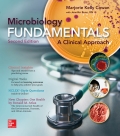
EBK MICROBIOLOGY FUNDAMENTALS: A CLINIC
2nd Edition
ISBN: 9781259293856
Author: Cowan
Publisher: MCGRAW HILL BOOK COMPANY
expand_more
expand_more
format_list_bulleted
Question
Chapter 14.4, Problem 9AYP
Summary Introduction
To determine:
The similarities and differences between type II and type III hypersensitivities.
Introduction:
The initial exposure to antigen results in the production of antibodies which circulate in body fluids. The second exposure of this antigen in body results in the formation of antigen-antibody (Ag-Ab) complexes. These Ag-Ab complexes recruits components of inflammatory reaction like complement and neutrophils. These complement eliminate Ag-Ab complex as normal immune response.
Expert Solution & Answer
Want to see the full answer?
Check out a sample textbook solution
Students have asked these similar questions
Can I get a handwritten answer please. I'm having a hard time understanding this process. Thanks
Say you get AATTGGCAATTGGCAATTGGCAATTGGCAATTGGCAATTGGCAATTGGC 3ʹ and it is cleaved with Mspl restriction enzyme - how do I find how many fragments?
What is amplification bias?
Chapter 14 Solutions
EBK MICROBIOLOGY FUNDAMENTALS: A CLINIC
Ch. 14.1 - Define immunopathology, and identify the two major...Ch. 14.1 - Identify the four major categories of...Ch. 14.2 - Prob. 1NPCh. 14.2 - Prob. 2NPCh. 14.2 - Summarize genetic and environmental factors that...Ch. 14.2 - Identify three conditions caused by IgE-mediated...Ch. 14.2 - Identify the two clinical forms of anaphylaxis,...Ch. 14.2 - Prob. 6AYPCh. 14.3 - List the three immune components causing cell...Ch. 14.3 - Prob. 8AYP
Ch. 14.4 - Prob. 9AYPCh. 14.5 - Prob. 10AYPCh. 14.5 - List four classes of grafts, and explain how host...Ch. 14.6 - List at least three autoimmune diseases and the...Ch. 14.6 - Prob. 3NPCh. 14.7 - Distinguish between primary and secondary...Ch. 14.7 - Prob. 4NPCh. 14 - Prob. 1CTCh. 14 - Which statement is true of autoimmunity? a. It...Ch. 14 - Prob. 1VCCh. 14 - Prob. 2CTCh. 14 - Prob. 2MCQCh. 14 - Prob. 3CTCh. 14 - Prob. 3MCQCh. 14 - Prob. 4CTCh. 14 - Prob. 4MCQCh. 14 - Prob. 5CTCh. 14 - Prob. 5MCQCh. 14 - Prob. 6MCQCh. 14 - Prob. 7MCQCh. 14 - Prob. 8MCQ
Knowledge Booster
Similar questions
- What would happen if transcriptome analysis were done on liver and muscle cells?arrow_forwardBiology How many grams of sucrose would you add to 100mL of water to make a 100 mL of 5% (w/v) sucrosesolution?arrow_forwardWhich marker does this DNA 5ʹ AATTGGCAATTGGCAATTGGCAATTGGCAATTGGCAATTGGCAATTGGC 3ʹ show?arrow_forward
- The Z value of LOD for two genes is 4, what does it mean for linkage and inheritance?arrow_forwardBiology How will you make a 50-ul reaction mixture with 2uM primer DNA using 10 uM primer DNA stocksolution and water?arrow_forwardBiology You’re going to make 1% (w/v) agarose gel in 0.5XTBE buffer 100 ml. How much agarose are you goingto add to 100 ml of buffer? The volume of agaroseis negligible.arrow_forward
- Biology How will you make a 50-ul reaction mixture with0.2 mM dNTP using 2-mM dNTP stock solution andwater?arrow_forwardBiology What is 200 pmole/uL in Molar concentration?arrow_forwardBiology How will you make a 50-ul reaction mixture with 1Xreaction buffer in it using water and 5X buffer stocksolution?arrow_forward
- Biology How would you make 200 uL of 10 pmole/uLprimer DNA solution using the 200 pmole/uLprimer DNA stock solution and distilled water?arrow_forwardBiology Now you have the 5 M of NaCl stock solution. Howwould you make one liter of 100 mM NaCl solutionusing the 5 M of NaCl solution and distilled water?arrow_forwardDevelopmental Biology Lab Question How to make one liter of 5 M NaCl stock solution?The molar weight of NaCl is 58.44 g/mol.(Molecular weight is 58.44 Dalton or amu).arrow_forward
arrow_back_ios
SEE MORE QUESTIONS
arrow_forward_ios
Recommended textbooks for you
 Human Physiology: From Cells to Systems (MindTap ...BiologyISBN:9781285866932Author:Lauralee SherwoodPublisher:Cengage Learning
Human Physiology: From Cells to Systems (MindTap ...BiologyISBN:9781285866932Author:Lauralee SherwoodPublisher:Cengage Learning Human Biology (MindTap Course List)BiologyISBN:9781305112100Author:Cecie Starr, Beverly McMillanPublisher:Cengage Learning
Human Biology (MindTap Course List)BiologyISBN:9781305112100Author:Cecie Starr, Beverly McMillanPublisher:Cengage Learning


Human Physiology: From Cells to Systems (MindTap ...
Biology
ISBN:9781285866932
Author:Lauralee Sherwood
Publisher:Cengage Learning



Human Biology (MindTap Course List)
Biology
ISBN:9781305112100
Author:Cecie Starr, Beverly McMillan
Publisher:Cengage Learning
